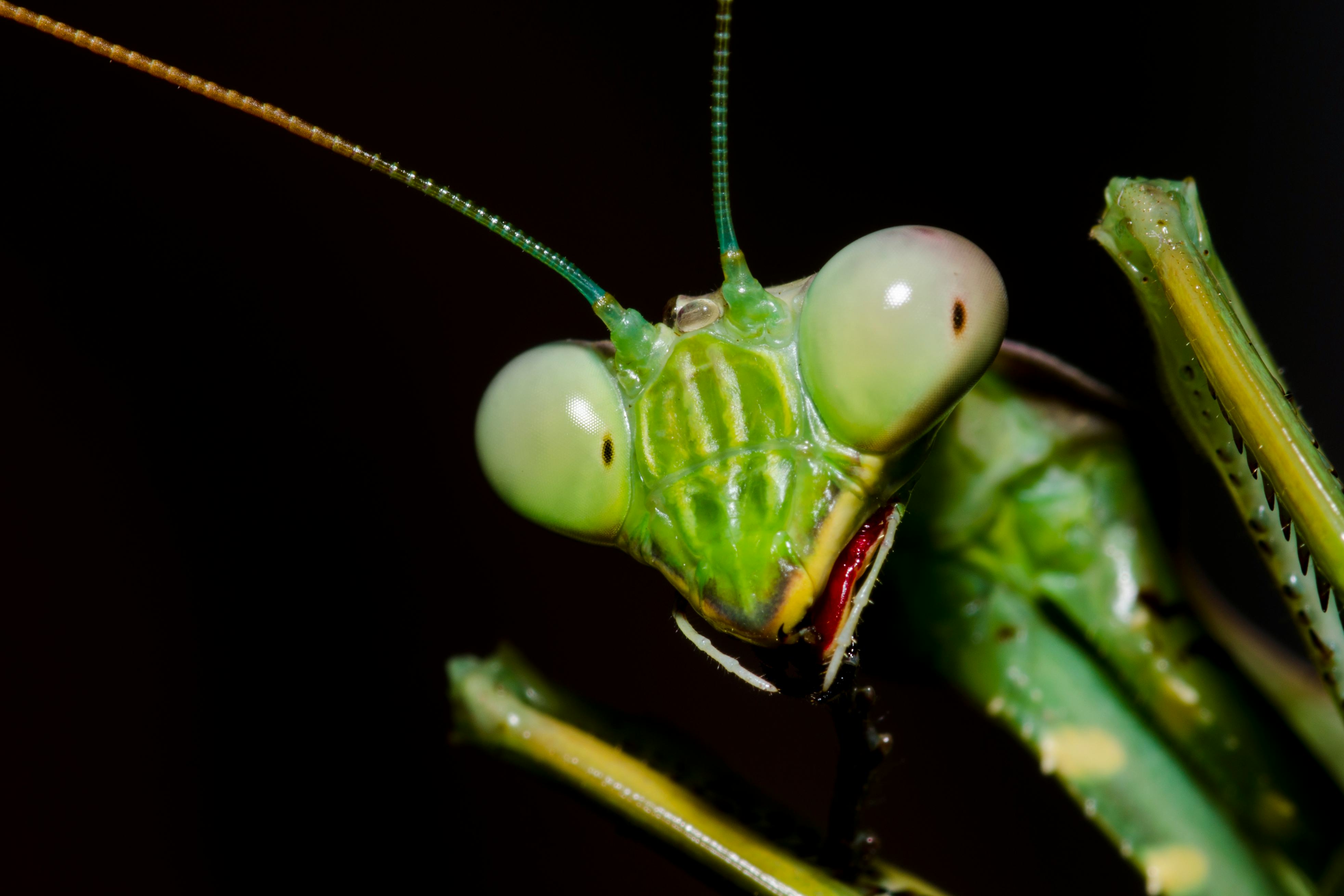
Finding a suitable partner can often feel like a life-and-death struggle. But sometimes, the stakes are really that high.
The Springbok Mantis (Miomantis caffra) has acquired a particularly brutal reputation for sexual cannibalism. The female mantis consumes the male prior to, during, or after copulation.
In a study published Tuesday in the journal Biology Letters, scientists provide a gruesome update on this mechanism's evolutionary purpose.
Prior to this study, scientists didn't understand why sexual cannibalism would benefit the mantis from an evolutionary standpoint. This research shows that the male mantis has taken to fighting back — occasionally avoiding becoming his female partner's next meal and allowing the cycle to continue.
Some background — Among sexually cannibalistic species, males typically bear the greater evolutionary burden.
To put it bluntly: female cannibals can bulk up on nutrients and increase their chances of survival by consuming dead males. Dead males cannot reproduce.
Moreover, female Springbok mantises can asexually reproduce from unfertilized eggs in a process known as facultative parthenogenesis. Male mantises need female mantises to pass on their genes, but the need is not so great for females.
In turn, it is evolutionarily beneficial for the female mantis to consume her potential partner. More than 60 percent of encounters between female and male mantises result in cannibalism.
In order to maximize their chances of survival, male mantises typically approach females cautiously, bearing gifts or attempting to mate while the female is already feeding.
Anecdotally, scientists have also reported seeing fights break out between male and female mantises. This study's researchers wanted to study these violent mating behaviors in a closed laboratory setting.
How they did it — The scientists gathered the mantis subjects, placing each insect in separate "housing."
The researchers paired virgin males and females together and observed a series of mating through an upturned plastic cup. They also made sure the females were well-fed beforehand, satiating their appetite with house flies the night before.
What was discovered — Before this study, violent male mating behaviors among sexually cannibalistic species had only been scientifically observed in male spiders who immobilize female partners with venom or ensnare them in a silky web.
This study confirms that male mantises also display these same coercive behaviors in order to reproduce — and stave off being eaten by the female.
In the mating trials, researchers observed male and female mantises would fight to subdue the other in a Gladiator-style showdown. The first insect to grasp its sparring partner would be considered the "winner" of the match.
"We show that pre-mating struggles in this species involve a physical battle in which each sex vies to be the first to subdue the other with their raptorial forelegs," the study team writes.
Out of the 52 total trials, only 29 resulted in physical contact between males and females. When physical contact did occur, things quickly got violent.
Males always initiated contact by jumping on their assigned female. Most of these encounters escalated to a violent struggle, where females responded aggressively.
Thirty-five percent of these violent struggles resulted in the female being the winner, who showed the male victim no mercy.
Males won about 58 percent of the time. These were brief victories.
While more than two-thirds of male winners went on to mate with the female, the females often still ate the males after successful copulation. The male ultimately passed on his genes, and that's all that matters when it comes to evolution.
What was especially shocking to the study team was proof of male coercive behavior resulting in injuries to female mantises.
Four out of the females that lost to males displayed considerable injuries from the mating encounter. The male had pierced the female abdomen with its claws, resulting in blood loss and scarring.
The study states: "Half of the males that injured females in this way obtained matings, while the other half escaped without mating or being eaten."
What's next — Scientists still don't know whether male mantises that became injured during the course of sexual fights ultimately suffered a shorter lifespan, thereby affecting the reproductive capabilities — and evolution — of the male M. caffra.
Scientists also question whether male and female mantises also duke it out in the wild, away from controlled laboratory settings. Evidence suggests yes — the team has collected wild females with scar tissue "consistent with male-inflicted injury" — but further studies are needed to confirm.
It's a twist on eat or be eaten. Sometimes, all you can do is stall dinner.
Abstract: Sexual conflict can generate coercive traits in males that enhance mating successat the expense of female fitness. Pre-copulatory sexual cannibalism—where females consume males without mating—typically favours cautious rather than coercive mating tactics, and few examples of the latter are known. Here, we show that males of the highly cannibalistic Springbok mantis,Miomantiscaffra, wrestle females during pre-mating interactions. We find that most initial contacts between males and females involve a violent struggle whereby each sex tries be the first to grasp hold of the other with their raptorial forelegs. When females win the struggle, they always cannibalize males. However, when males grasp females first, they dramatically increase the chance ofmating. We also find striking evidence that, on some occasions, males wound females with their foretibial claws during struggles, resulting in haemolymphloss and scar tissue formation. Taken together, our results show how males can overcome the threat of cannibalism by coercively wrestling females. We argue that pre-copulatory injury in this species is likely to be a negative pleiotropic side-effect of coercive mating behaviour and foraging morphology.







